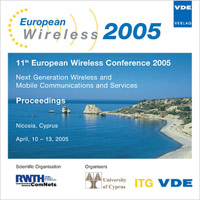A Performance Comparison of QoS Approaches for Ad Hoc Networks: 802.11e versus Distributed Resource Allocation
Conference: European Wireless 2005 - 11th European Wireless Conference 2005 - Next Generation wireless and Mobile Communications and Services
04/10/2006 - 04/13/2005 at Nicosia, Cyprus
Proceedings: European Wireless 2005
Pages: 6Language: englishTyp: PDF
Personal VDE Members are entitled to a 10% discount on this title
Authors:
Carlson, Emma; Wolisz, Adam (Technische Universität Berlin, Telecommunication Networks Group, Berlin, Germany)
Bettstetter, Christian; Prehofer, Christian (DoCoMo Euro-Labs, Future Networking Lab, Munich, Germany)
Abstract:
We compare two approaches for Quality of Service support in WLAN-based ad hoc networks. The first approach is to use per-packet priorities, according to the IEEE 802.11e standard. The second approach is to allocate radio resources on the path between source and destination, according to our protocol 'Distributed end-to-end Allocation of time slots for REal-time traffic' (DARE). Performance simulations show the following results: In case of low load, IEEE 802.11e has slightly lower end-to-end delay and higher packet loss rate, since it does not use any coordination among nodes for real-time packets. In case of medium load, DARE is superior in terms of jitter, delay, and packet loss. In case of high load, DARE clearly outperforms 802.11e. The results still hold if DARE has to repair the resource reservation path due to node failures.


